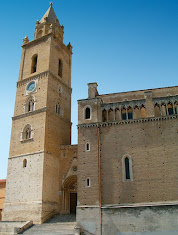Leading figure in the Neapolitan Enlightenment
The economist and philosopher Ferdinando Galiani, whose theories on market economics are considered to be years ahead of his time, was born on this day in 1728 in Chieti, now in Abruzzo but then part of the Kingdom of Naples.Ferdinando Galiani spent much of
his life in government service
Galiani spent much of his life in the service of the Naples government, spending 10 years as secretary to the Neapolitan ambassador in Paris before returning to Naples in the role of councillor of the tribunal of commerce, being appointed administrator of the royal domains in 1777.
A fine writer and wit as well as a talented economist, Galiani wrote a number of humorous works as well as two significant treatises, the first of which, Della Moneta, was written while he was still a student, at the age of 22.
Initially published anonymously, Della Moneta - On Money - was ostensibly a work about the history of money and the monetary system, but Galiani used it as an opportunity to intervene in the Neapolitan debate on economic reform, his opinions on the development of the Neapolitan economy evolving into a theory of market value based on utility and scarcity.
At the same time, he put forward what was then a revolutionary notion of the importance of freedom to the well-being of any society, one shared by many contemporary thinkers, including the French writer and philosopher Voltaire.
Advancing arguments based on the principle of personal freedom, Galiani suggested that the value of anything should be determined by the mutual agreement of buyer and seller, with prices and wages set naturally according to demand.
 |
| Galiani's seminal work, Della Moneta, which he wrote at 22 |
Galiani’s views on fairness could almost certainly be attributed to the education he received from his uncle, Monsignor Celestino Galiani, a prominent archbishop, whose intention was to prepare his nephew for a life as a clergyman.
In the event, Galiani revealed a talent not only for economics but as a witty writer, whose clever parodies of the Neapolitan literary style established his reputation as a humorist. In all his writing, however, he was faithful to the fundamental principles of truth and justice imbued in him by his uncle.
During his time in Paris, Galiani wrote his second important treatise, Dialogues sur le commerce des blés - Dialogues on the Grain Trade - in which he argued in favour of regulation of the corn market on the basis that free international trade in grain, not so much a commodity as a necessity, risked the wellbeing of the population if foreign markets were more attractive to producers than domestic ones.
Galiani wrote fluently in both French and Italian, and his letters are seen as valuable for their depiction of economic, social, and political life in 18th-century Europe. He died in Naples in 1787 at the age of 58.
Travel tip:Chieti's Baroque Cathedral
of San Giustino
Chieti, the capital of the Abruzzi region, is among the most historic Italian cities, reputedly founded in 1181BC by the Homeric Greek hero Achilles and named Theate in honour of his mother, Thetis. The city is notable for the Gothic Cathedral of San Giustino, which has a Romanesque crypt dated at 1069 but is mainly of later construction, having been rebuilt a number of times, usually because of earthquake damage. The main part of the cathedral is in early 18th century Baroque style. Situated about 20km (12 miles) inland from the Adriatic city of Pescara, the city consists of Chieti Alta, the higher part and the historic centre, and the more modern Chieti Scalo.
Travel tip:Pescara, with the snow-capped mountains of the
Gran Sasso range in the background
Pescara, a city of almost 120,000 people on the Adriatic in the Abruzzo region, is known for its 10 miles of clean, sandy beaches, yet is only 50km (31 miles) from the Gran Sasso mountain range, the snow-capped peaks of which are visible even from the coast on a clear winter’s day. The city is the birthplace of the poet, patriot and military leader, Gabriele D’Annunzio. His childhood home, the Casa Natale di Gabriele D’Annunzio, which can be found in the historic centre of the city on the south side of the Fiume Pescara, which bisects the city, houses a museum about his life and works. The Museo delle Genti d'Abruzzo has exhibitions on regional industries like ceramics and olive oil. Pieces by Miró and Picasso are on view at the Vittoria Colonna Museum of Modern Art.
Also on this day:
1684: The birth of cook and unlikely war hero Maria Bricca
1916: The death of composer Paolo Tosti
1930: The birth of fashion designer Roberto Capucci
1946: The birth of fashion designer Gianni Versace















